#ccrb
Text
How the NYPD defeated bodycams

Anything that can't go on forever will eventually stop. When American patience for racial profiling in traffic stops reached a breaking point, cops rolled out dashcams. Dashcam footage went AWOL, or just recorded lots of racist, pretextual stops. Racial profiling continued.
Tasers and pepper spray were supposed to curb the undue use of force by giving cops an alternative to shooting dangerous-seeming people. Instead, we got cops who tasered and sprayed unarmed people and then shot them to pieces.
Next came bodycams: by indelibly recording cops' interactions with the public, body-worn cameras were pitched as a way to bring accountability to American law-enforcement. Finally, police leadership would be able to sort officers' claims from eyewitness accounts and figure out who was lying. Bad cops could be disciplined. Repeat offenders could be fired.
Police boosters insist that police violence and corruption are the result of "a few bad apples." As the saying goes, "a few bad apples spoil the bushel." If you think there are just a few bad cops on the force, then you should want to get rid of them before they wreck the whole institution. Bodycams could empirically identify the bad apples, right?
Well, hypothetically. But what if police leadership don't want to get rid of the bad apples? What if the reason that dashcams, tasers, and pepper spray failed is that police leadership are fine with them? If that were the case, then bodycams would turn into just another expensive prop for an off-Broadway accountability theater.
What if?
In "How Police Have Undermined the Promise of Body Cameras," Propublica's Eric Umansky and Umar Farooq deliver a characteristically thorough, deep, and fascinating account of the failure of NYPD bodycams to create the accountability that New York's political and police leadership promised:
https://www.propublica.org/article/how-police-undermined-promise-body-cameras
Topline: NYPD's bodycam rollout was sabotaged by police leadership and top NYC politicians. Rather than turning over bodycam footage to oversight boards following violent incidents, the NYPD suppresses it. When overseers are allowed to see the footage, they get fragmentary access. When those fragments reveal misconduct, they are forbidden to speak of it. When the revealed misconduct is separate from the main incident, it can't be used to discipline officers. When footage is made available to the public, it is selectively edited to omit evidence of misconduct.
NYPD policy contains loopholes that allow them to withhold footage. Where those loopholes don't apply, the NYPD routinely suppresses footage anyway, violating its own policies. When the NYPD violates its policies, it faces no consequences. When overseers complain, they are fired.
Bodycams could be a source of accountability for cops, but for that to be true, control over bodycams would have to vest with institutions that want to improve policing. If control over bodycams is given to institutions that want to shield cops from accountability, that's exactly what will happen. There is nothing about bodycams that makes them more resistant to capture than dashcams, tasers or pepper spray.
This is a problem across multiple police departments. Minneapolis, for example, has policies from before and after the George Floyd uprisings that require bodycam disclosure, and those policies are routinely flouted. Derek Chauvin, George Floyd's murderer, was a repeat offender and had been caught on bodycam kneeling on other Black peoples' necks. Chauvin once clubbed a 14 year old child into unconsciousness and then knelt on his neck for 15 minutes as his mother begged for her child's life. Chauvin faced no discipline for this and the footage was suppressed.
In Montgomery, Alabama, it took five years of hard wrangling to get access to bodycam footage after an officer sicced his attack dog on an unarmed Black man without warning. The dog severed the man's femoral artery and he died. Montgomery PD suppressed the footage, citing the risk of officers facing "embarrassment."
In Memphis, the notoriously racist police department was able to suppress bodycam disclosures until the murder of Tyre Nichols. The behavior of the officers who beat Nichols to death are a testament to their belief in their own impunity. Some officers illegally switched off their cameras; others participated in the beating in full view of the cameras, fearing no consequences.
In South Carolina, the police murder of Walter Scott was captured on a bystander's phone camera. That footage made it clear that Scott's uniformed killers lied, prompting then-governor Nikki Haley to sign a law giving the public access to bodycam footage. But the law contained a glaring loophole: it made bodycam footage "not a public record subject to disclosure." Nothing changed.
Bodycam footage does often reveal that killer cops lie about their actions. When a Cincinnati cop killed a Black man during a 2015 traffic-stop, his bodycam footage revealed that the officer lied about his victim "lunging at him" before he shot. Last summer, a Philadelphia cop was caught lying about the circumstances that led to him murdering a member of the public. Again, the officer claimed the man had "lunged at him." The cop's camera showed the man sitting peacefully in his own car.
Police departments across the country struggle with violent, lying officers, but few can rival the NYPD for corruption, violence, scale and impunity. The NYPD has its own "goon squad," the Strategic Response Group, whose leaked manual reveals how the secret unit spends about $100m/year training and deploying ultraviolent, illegal tactics:
https://pluralistic.net/2021/04/07/cruelty-by-design/#blam-blam-blam
The NYPD's disciplinary records – published despite a panicked scramble to suppress them – reveal the NYPD's infestation with criminal cops who repeatedly break the law in meting out violence against the public:
https://pluralistic.net/2020/07/27/ip/#nypd-who
These cops are the proverbial bad apples, and they do indeed spoil the barrel. A 2019 empirical analysis of police disciplinary records show that corruption is contagious: when crooked cops are paired with partners who have clean disciplinary records, those partners become crooked, too, and the effect lasts even after the partnership ends:
https://journals.sagepub.com/doi/full/10.1177/2378023119879798
Despite the risk of harboring criminals in police ranks, the NYPD goes to extreme lengths to keep its worst officers on the street. New York City's police "union"'s deal with the city requires NYC to divert millions to a (once) secret slushfund used to pay high-priced lawyers to defend cops whose conduct is so egregious that the city's own attorneys refuse to defend them:
https://pluralistic.net/2021/03/26/overfitness-factor/#heads-you-lose-tails-they-win
This is a good place for your periodic reminder that police unions are not unions:
https://pluralistic.net/2020/07/28/afterland/#selective-solidarity
Indeed, despite rhetoric to the contrary, policing is a relatively safe occupation, with death rates well below the risks to roofers, loggers, or pizza delivery drivers:
https://pluralistic.net/2022/01/27/extraordinary-popular-delusions/#onshore-havana-syndrome
The biggest risk to police officers – the single factor that significantly increased death rates among cops – is police unions themselves. Police unions successfully pressured cities across American to reject covid risk mitigation, from masking to vaccinations, leading to a wave of police deaths. "Suicide by cop" is very rare, but US officers committed "mass suicide by cop union":
https://www.nytimes.com/2021/10/12/us/police-covid-vaccines.html
But the story that policing is much more dangerous than it really is a useful one. It has a business-model. Military contractors who turn local Barney Fifes into Judge Dredd cosplayers with assault rifles, tanks and other "excess" military gear make billions from the tale:
https://pluralistic.net/2020/07/10/flintstone-delano-roosevelt/#1033-1022
It's not just beltway bandits who love this story. For cops to be shielded from consequences for murdering the public, they need to tell themselves and the rest of us that they are a "thin blue line," and not mere armed bureaucrats. The myth that cops are in constant danger from the public justifies hair-trigger killings.
Consider the use of "civilian" to describe the public. Police are civilians. The only kind of police officer who isn't a civilian is a military policeman. Places where "civilians" interact with non-civilian law enforcement are, by definition, under military occupation. Calling the public "civilians" is a cheap rhetorical trick that converts a police officer to a patrolling soldier in hostile territory. Calling us "civilians" justifies killing us, because if we're civilians, then they are soldiers and we are at war.
The NYPD clearly conceives of itself as an occupying force and considers its "civilian" oversight to be the enemy. When New York's Civilian Complaint Review Board gained independence in 1993, thousands of off-duty cops joined Rudy Giuliani in a mass protest at City Hall and an occupation of the Brooklyn Bridge. This mass freakout is a measure of police intolerance for oversight – after all, the CCRB isn't even allowed to discipline officers, only make (routinely ignored) recommendations.
Kerry Sweet was the NYPD lawyer who oversaw the department's bodycam rollout. He once joked that the NYPD missed a chance to "bomb the room" where the NYPD's CCRB was meeting (when Propublica asked him to confirm this, he said he couldn't remember those remarks, but "on reflection, it should have been an airstrike").
Obvious defects in the NYPD's bodycam policy go beyond the ability to suppress disclosure of the footage. The department has no official tracking system for its bodycam files. They aren't geotagged, only marked by officer badge-number and name. So if a member of the public comes forward to complain that an unknown officer committed a crime at a specific place and time, there's no way to retrieve that footage. Even where footage can be found, the NYPD often hides the ball: in 20% of cases where the Department told the CCRB footage didn't exist, they were lying.
Figuring out how to make bodycam footage work better is complex, but there are some obvious first steps. Other cities have no problem geotagging their footage. In Chicago, the CCRB can directly access the servers where bodycam footage is stored (when the NYPD CCRB members proposed this, they were fired).
Meanwhile, the NYPD keeps protecting its killers. The Propublica story opens with the police killing of Miguel Richards. Richards' parents hadn't heard from him in a while, so they asked his Bronx landlord to check on him (the Richards live in Jamaica). The landlord called the cops. The cops killed Richards.
The cops claimed he had a gun and they were acting in self-defense. They released a highly edited reel of bodycam footage to support that claim. When the full video was eventually extracted, it revealed that Richards had a tiny plastic toy guy and a small folding knife. The officers involved believed he was suffering an acute mental health incident and stated that policy demanded that they close his bedroom door and wait for specialists. Instead, they barked orders at him and then fired 16 rounds at him. Seven hit him. One ruptured his aorta. As he lay dying on his bedroom floor, one officer roughly tossed him around and cuffed him. He died.
New York's Police Benevolent Association – the largest police "union" in NYC – awarded the officers involved its "Finest of the Finest" prize for their conduct in the killing.
This isn't an isolated incident. A month after the NYPD decided not to punish the cops who killed Richards, NYPD officers murdered Kawaski Trawick in his Bronx apartment:
https://pluralistic.net/2020/12/04/kawaski-trawick/#Kawaski-Trawick
The officers lied about it, suppressed release of the bodycam footage that would reveal their lies, and then escaped any justice when the footage and the lies were revealed.
None of this means that bodycams are useless. It just means that bodycams will only help bring accountability to police forces when they are directed by parties who have the will and power to make the police accountable.
When police leaders and city governments support police corruption, adding bodycams won't change that fact.

If you'd like an essay-formatted version of this post to read or share, here's a link to it on pluralistic.net, my surveillance-free, ad-free, tracker-free blog:
https://pluralistic.net/2023/12/13/i-want-a-roof-over-my-head/#and-bread-on-the-table

Image:
Cryteria (modified)
https://commons.wikimedia.org/wiki/File:HAL9000.svg
CC BY 3.0
https://creativecommons.org/licenses/by/3.0/deed.en
--
Tony Webster, modified
https://commons.wikimedia.org/wiki/File:Minneapolis_Police_Officer_Body_Camera_%2848968390892%29.jpg
CC BY-SA 2.0
https://creativecommons.org/licenses/by-sa/2.0/deed.en
#pluralistic#impunity#ccrb#nypd#abolish the police#acab#police#corruption#bodycams#body-worn cameras#propublica
3K notes
·
View notes
Text
A cop that somehow makes the rank of lieutenant, despite over 50 violations of conduct, complains of having to retire whike facing ZERO criminal charges.
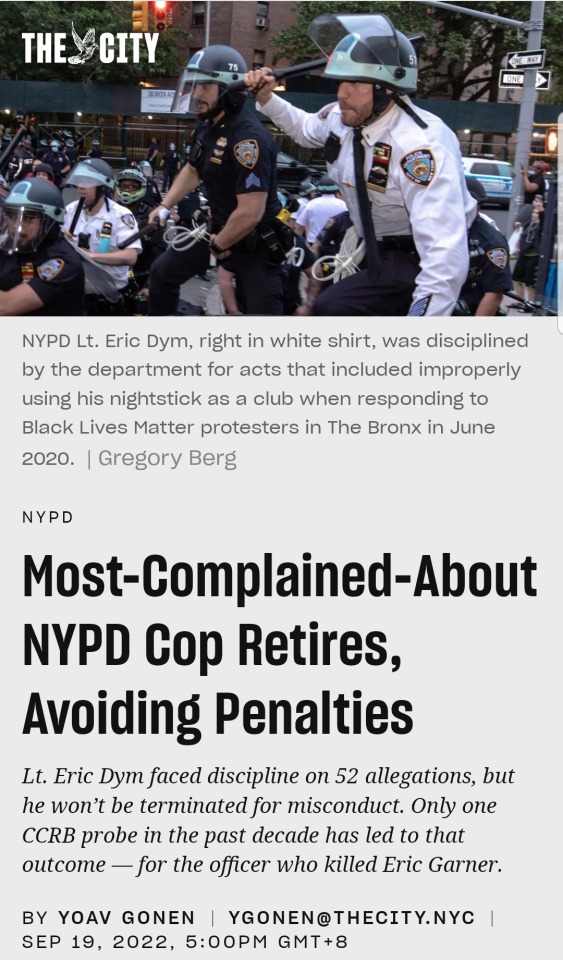
An NYPD lieutenant who had been facing discipline for 52 substantiated allegations of misconduct is retiring instead — avoiding penalties in three cases and getting docked 64 vacation days in five others, THE CITY has learned.
By putting in his retirement papers, Dym will avoid facing discipline for 29 of the charges brought by the CCRB — including four instances of pointing a gun at someone, three incidents of improper physical force and one case of making a false official statement.
The presumed penalty for a false statement alone is termination, under a disciplinary matrix implemented by the police department last year.
Dym has also been named in more than a dozen lawsuits filed against the NYPD, a number of them alleging assault by Dym and other cops, which have resulted in over $1.5 million in settlements so far, records show.
...[I]n order to strip-search a man in a holding cell after police had found him carrying a dime-bag of marijuana, Dym allegedly punched the man repeatedly, pushed his knees into the man’s body as the man lay in a fetal position and performed the cavity search, according to the CCRB.
It gets worse.
“What his detractors or critics classify as aggressive or problematic policing is anything but that,” said Moschella. “He wasn’t a lieutenant to sit back and watch what was occurring up in those neighborhoods, in the 40 Precinct, in the 41 Precinct, and sit back and just let it happen.”
Moschella added that while Dym retired on his own timeline, he had gotten the CCRB’s message loud and clear that his method of policing wasn’t appreciated for its effectiveness in reducing crime.
“He could not perform the type of policing that he believed was necessary, so he chose on his own volition to retire from the police department,” said Moschella. “And that is exactly what the CCRB wanted.”
Dym, who earned nearly $216,000 in total pay last year including overtime, agreed to a negotiated settlement with the CCRB to resolve three cases in which he would have faced an administrative trial, in exchange for giving up 46 vacation days, according to CCRB spokesperson Clio Calvo-Platero.
6 notes
·
View notes
Link
0 notes
Note
ChaLynn Cheer Cap heeey!
I been saying this for a long time now. Willow is right where she needs to be. Let boring Michael take care of her and their newfound cult family. Their "love story" is so bland and inorganic as unseasoned picnic food at a shotgun wedding. (insert Millow's wedding family photo) Michael got on my last nerve this entire week, his boring unseasoned dry as burnt toast love for Willow made me wanna hurl. Match made in heaven. (Doh, I hope I didn't speak too soon) lol
Tracy Q. is queen. She showed up and showed out at Frankenstein's bride wedding. Without her this would be a fake wedding, a wake. Ha! Speaking of being on death row and getting married it does bring out a certain glow doesn't it? Chase sure as hell dodged a huge bullet there. Team Krissy all theway, Joss lookin sideways at her like she stole her future. Get ready chica, Krissy just might do the damn thing. Meowch! Sante looked amazing. The ambiance of the wedding was amazing. The guests looked amazing. Maxie looked amazing. The Bensons are gonna get iiiit!
The SEC showing up at the end was the icing on that store bought sheet cake Olivia got hiding in the fridge for later. So Carly is getting popped for insider trading and I'm loving every bit of it. Tracy was right, Carly just doesn't blend well with the Qs. It will never feel right with her in Monica's house, the one Alan gave to her. Her chin in the air and her cult leader behavior and feeding Willow a bunch of bs about family and womanhood makes my flawless skin crawl.
Nina is messy and got a couple of screws loose but I'm here for it. Loved Ava being the voice of reason even though it was too late to call off the authorities. Anyone who can get the book thrown at Carly and live to tell about it is okay in my book. CarSon or not, Nina just gonna have to deal with it. That eclipse is coming girl!! Sonny has had her back time and time again. I can't imagine what will happen now.
Chase and BLQ... Ay ay ay! Despite the victory of getting rid of Linc and Chase getting his job back, I wasn't a fan of how the ends got tied up (bad, messy writing). B is scared to tell Chase that Tracy helped call in a favor. She thinks Chase will be disappointed in her again. Bollocks! It's no big deal, her efforts will be rewarded generously. Chase wants her back. When he talks about how he feels about B, he stops short when it comes to moving on without her. He's had that time away from B to realize what he truly wants. Regardless of B's shortcomings, she is what he needs in his life. Today's wedding encounters were no different. B did everything she could to keep busy and away from Chase's fine ass. Their lives are interconnected in many ways and that dang universe keeps bringing them back to each other every single time. When B showed up at the ccrb meeting, Chase thought he would have to face that panel of strangers with his fate in their hands alone. When B spoke from her heart, she gave Chase a jolt of renewed sense of purpose, that second wind he never knew he need till then. Any confusions he had before were gone. He'd made up his mind right then and there when he told her whatever happens that he would be okay. Chase shut it down quick when B was trying to suggest moving on with Blaze (and without her in his life). He chooses their history, his love for her. Falling in love looks good on B, on both actually. She is willing to give up her happiness being with him so he can be happy doing what he loves doing; being a cop. His love for her becomes stronger every time he thinks of moving on without her and visa verse. They can't know what the other is feeling unless they really talk to each other. There's not much obstacles between them now but angst, misery and fear. Only time will tell, so post haste you two.
Hey! Nice to hear from you!
And everything you said is so true! Every single word.
1 note
·
View note
Text
0 notes
Text
NYPD watchdog CCRB hosts January board meeting in Harlem
The Civilian Complaint Review Board (CCRB) kicked off the year uptown, with the NYPD watchdog holding 2023’s first monthly board meeting at Harlem Hospital Center last Wednesday, Jan. 11.
“[We want] people in this neighborhood to have easy access to our board members and share their experiences and ask questions,” said CCRB interim chair Arva Rice.
For local violence-interruption groups like…
View On WordPress
0 notes
Text
NYPD detectives union slams CCRB for seeking to ID informants#NYPD #detectives #union #slams #CCRB #seeking #informants
NYPD detectives fear the city’s police watchdog agency is trying to take the “confidential” out of the term “confidential informant.”
A move by the Civilian Complaint Review Board to require information about confidential informants’ involvement in or knowledge of police misconduct is dangerous, police union officials told the Daily News.
Under a new CCRB policy, its investigators handling…
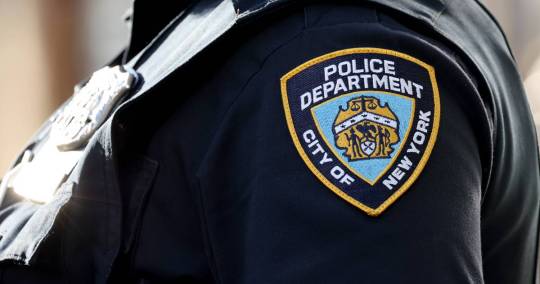
View On WordPress
0 notes
Note
how's your ccrb au going
that's just public domain now
0 notes
Photo
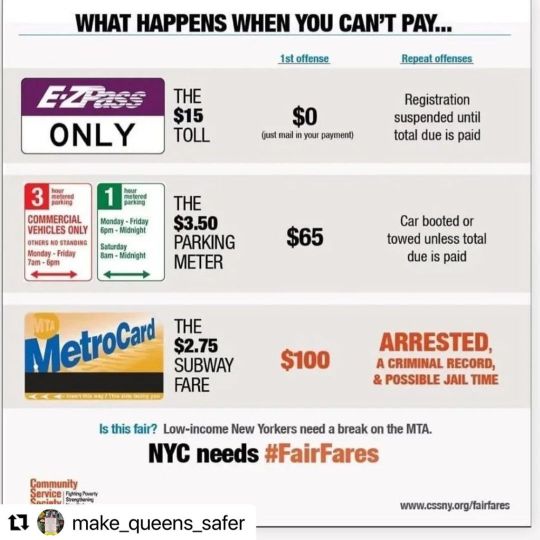
#Repost @make_queens_safer ・・・ This triggers that time my husband was handcuffed, put in a van with about 8 others and carted off to an unknown transit police location and held for 6 hours over the accusation of fare evasion. He didn't even do it. He went through the doors with the baby and baby stroller and I swiped. But the corrupt guy in charge sent him through all that. We did file a CCRB report. Sometimes the #fairfare is the difference of me going or staying home. @nycmayor @cmjuliewon Why do cars driven by unlicensed drivers not become @nypd property? (They kill #newyorkers) (at Geographic Center) https://www.instagram.com/p/Cc9AahJLLhW/?igshid=NGJjMDIxMWI=
0 notes
Link
“Unless the city is willing to give the CCRB some teeth, it will continue to be nothing more than the illusion of oversight. The NYPD has to answer to the public, and it has shown it's unwilling to do that on any level. New York legislators need to be willing to stare down the blue-uniformed 800-lb gorilla in its midst. If it can't, the NYPD will continue to be as awful as it has been for decades.”
2 notes
·
View notes
Photo


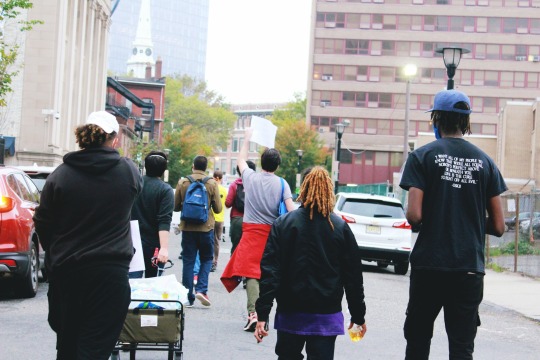







#T4I#NEWARK#CCRB#POP#BLACKLIVESMATTER#BLM#NCAP#ICC#CIVILIAN COMPLAINT REVIEW BOARD#POWER TO THE PEOPLE#BLACK LIVES MATTER
42 notes
·
View notes
Text
NYPD Trial For Eric Garner’s Killing Ends With No Resolution In Sight
NYPD Trial For Eric Garner’s Killing Ends With No Resolution In Sight
The verdict, whatever it is, may not be made public immediately and can be upheld, modified or even vacated.

The administrative NYPD trial to determine the fate of the officer who used an illegal chokehold to kill Eric Garner nearly five years ago has come to an end, according to reports. However, there was no telling when, or if, the trial’s verdict, let alone any punishments for Daniel…
View On WordPress
13 notes
·
View notes
Link
0 notes
Photo
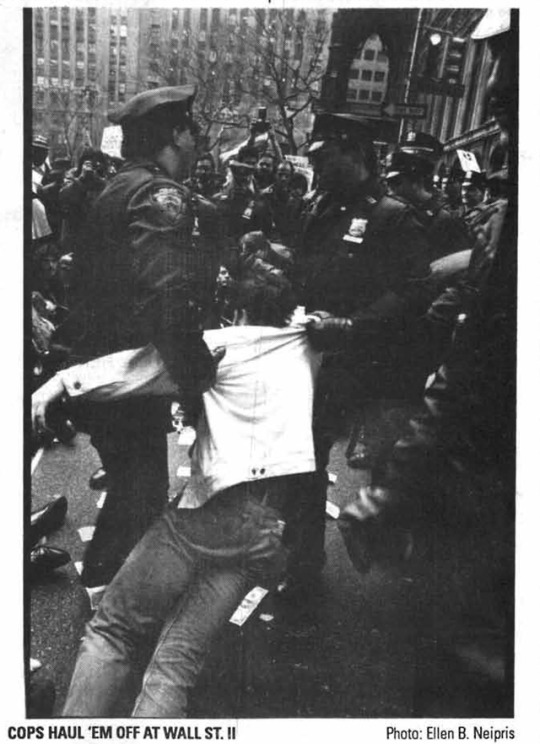
Police to ACT UP: no problem
NEW YORK [October 15, 1989] — Almost 16 months after it was asked to investigate well-documented charges of police bigotry and violence during an ACT UP demonstration, the New York City Police Department's Civilian Complaint Review Board (CCRB) found that there was "insufficient evidence" to document any of the complaints. But a civilian member of the board told ACT UP that he felt the police investigation into the complaints was inadequate.
The board's response came to light Monday night, October 2, when David Wertheimer of the New York City Gay and Lesbian Anti-Violence Project read a letter from the CCRB to the weekly meeting of ACT UP, With him was Dan Johnston, the only openly gay member of the CCRB,and one of six civilian members of the 12-member board.
"It is clearly the case here that [the CCRB] did not work worth a damn," Johnston told the crowd of 300 AIDS activists. Stressing that he spoke only for himself, Johnston apologized to ACT UP and the protesters, saying that once again it was obvious "you can't rely on the police department to investigate itself."
The protest occurred March 24, 1988, when several hundred AIDS activists held a sit-in on Wall Street to protest profiteering on AIDS drugs and a lack of government action to end the epidemic. During the action, known as "Wall Street II" to commemorate the first anniversary of ACT UP's very first demonstration (also held on Wall Street), 111 protesters were arrested.
The CCRB's letter, written by Sandra Marsh, who is both CCRB deputy commissioner and a uniformed police officer, said:
"After careful review of the evidence presented, the Board found that there was insufficient evidence to clearly prove or disprove the allegations that an officer punched several victims, grabbed one victim by the back of the neck, twisted his arm behind his back, shoved him, grabbed another victim by his ears, lifted him up, threw him into a seat, pulled another victim by the hair, was discourteous to the victims, another officer threatened one victim, an officer was discourteous, and an officer threatened another victim.
"With regards to the allegations that three unidentified officers threw some of the victims onto the bus, the Board found that the officers in question were unidentified."
But Wertheimer noted that his May 31 letter included statements from 13 demonstrators and four witnesses who saw or experienced exactly these abusive behaviors. Included in several complaints were the names and badge numbers of specific police officers.
Board member Johnston told the activists that be would be willing to help interested parties reconstruct the investigation, to determine whether CCRB investigators had not pursued available evidence during their investigation. And he termed their inquiries "wholly inadequate." All but a handful of CCRB investigators are police officers.
The Police Department has never set a standard as to what constitutes sufficient evidence to require an officer to stand trial on such charges.
— John Umlaut, OutWeek Magazine No. 17, October 15, 1989, p. 26.
#outweek#issue 17#lgbt history#hiv aids#act up#protest#wall street#wall street ii#police#ccrb#new york gay and lesbian anti-violence project#david wertheimer#dan johnston#news#john umlaut#out takes#photo#ellen b. neipris
1 note
·
View note
Photo

For @yudoridori’s Curious Case of the Ring Brothers competition on @tapas_app 💕 You can find me on Tapas at: https://tapas.io/enchantedviolin #ccrb_fanart #tapas #art #illustration #pink #fanart #ccrb #ringbros #ringbrothers #curiouscaseoftheringbrothers #birds #bird #positivity #positivevibes #positive
#ringbros#ringbrothers#ccrb_fanart#ccrb#fanart#positive#positivevibes#bird#pink#art#illustration#birds#positivity#tapas#curiouscaseoftheringbrothers
1 note
·
View note
